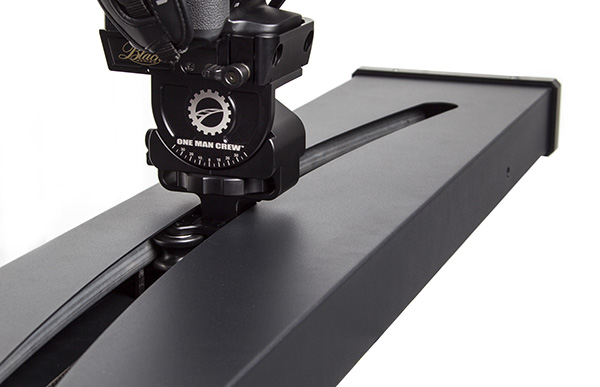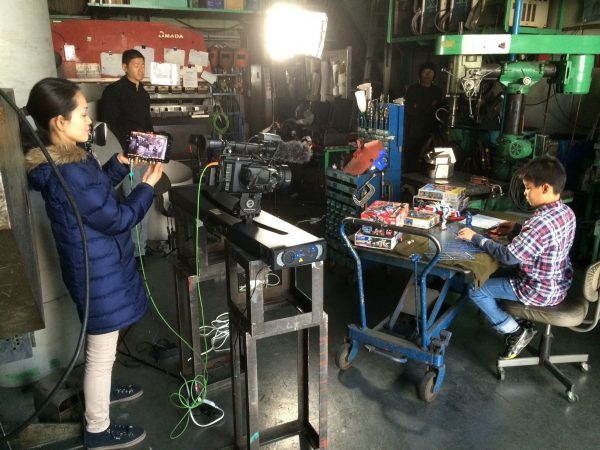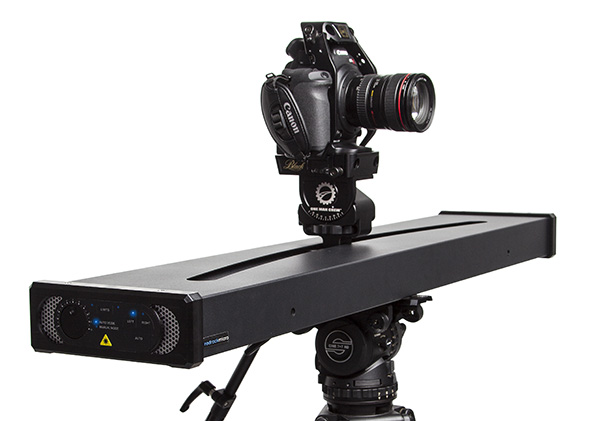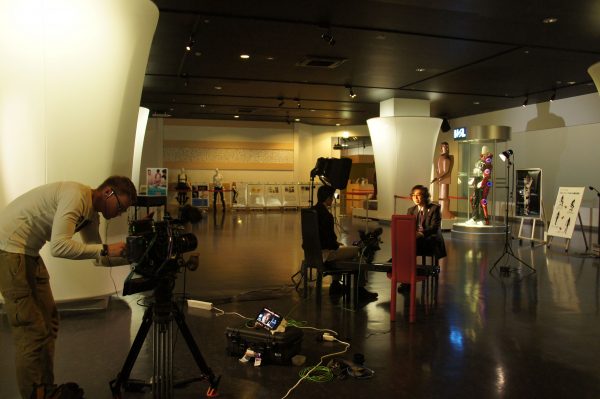By technical editor Matt Allard:
I almost always work in a one-man-band situation and that requires equipment that is easy to set up and use. As far as motion control devices go, the Redrockmicro One Man Crew is about as simple to operate as it gets. It is an all-in-one motorised parabolic slider – this might sound complicated, but it is essentially a slider with a curved rail that allows your camera to move back and forth while keeping your subject at the same position in the frame.

The One Man Crew can only be used as a parabolic slider – there is no way to make a straight slide with it. A motor moves the camera in one direction along the track and when it reaches the end it reverses and goes back in the opposite direction. This action is repeated for as long as you want and the idea of the setup is that you can leave your second camera running unattended for the entire duration of an interview, giving you a beautiful slow-moving cutaway shot. Better still, because the subject is kept in the same distance from the camera, it will stay in focus.

Setting up is super quick. You take it out of the bag, screw the included tripod head on, plug it into mains electricity and you are practically ready to go. All that remains to be done is to use the built-in laser guides to line up your subject – moving it closer or further away until the red dots vertically align. Normally this is fine, but the subject must be placed in a particular spot and the distance from the subject must be approximately 6 feet away for the effect to work. Occasionally I found that if I placed and framed up my ‘A’ interview camera first, it forced me to put the One Man Crew in a less than ideal position. Like everything this is a compromise and just something to be aware of when you are planning your shots. I found you could cheat a little and use the system without necessarily having the red dots line up – but it produced mixed results, working best when the range of the parabolic move was limited.
There are numerous settings and speed adjustments that you can tailor, from a simple back-and-forth move, to a 8 hour end-to-end time lapse. The controls are straightforward to use and you can be up and running within a few minutes.
There are several other parabolic slider systems out there now, but most require you to add bolt-on motors and a parabolic arm to achieve the same result. What attracted me to the One Man Crew was the fact that it is a self contained system. It weighs 14lb (6.3kg), which is pretty light considering what it does. The included tripod head will take a camera load of up to 20lb (9kg), so it will support a large range of cameras. I did find that if you have the tripod head pointed up or down at certain angles that weight limit is reduced.
The One Man Crew may not weigh that much but it is rather long by necessity, which can be a problem for transportation in some instances. At 46” (117cm) long you won’t be able to fit it in a suitcase or most tripod cases. It does come in its own soft case but care should be taken when transporting it on planes. I put additional bubble wrap inside my case to give it some extra protection.
Talking about the case, one small but useful thing Redrockmicro have done is print the operating instructions right on the inside. This way you always have a reference for use without worrying about losing paper instructions.

You can also power the One Man Crew from a battery source. They do sell a D-tap connector cable to allow DC battery powering. Luckily I found I already had a connection cable that worked from another piece of equipment. For shooters like me it is a must to have the ability to power gear in the field, as very often you just don’t have access to mains power. It is also worth mentioning that the One Man Crew doesn’t work without power and you can’t simply push it along as you can with some competing systems such as the Kessler Parallax.
The One Man Crew’s motor is both the hero and the villain of the unit. It is very smooth and precise. The speed ramps up and down very gradually as it starts or reaches the end of the track or its programmed movement. This gives you very soft and organic movement which works really well. I used the One Man Crew on numerous occasions with a 100mm macro lens and found the movement to be very smooth.
If you run the motor at lower speeds there is virtually no noise at all. The problems begins when you speed the unit up – it becomes quite noisy and this can become a factor when shooting interviews in quiet locations. While other users of the One Man Crew may argue that you don’t usually have the device moving fast during an interview, I disagree. To really get a sense of movement I found the device had to be set to at least a mid-range speed; otherwise, I didn’t see the point of using it. For many documentary or news shooters the actual part of the interview used in the edit may only last 10-15 seconds at a time. Maybe if I were to shoot more feature-length documentaries this would be different.
Unfortunately, the motor is also noticeably noisier when it moves in one direction rather than the other. I suspect this comes down to whether the motor is pushing or pulling the belt to move the camera along the rails.
It is also important to be aware that the unit will only be smooth when on a level solid surface or stand. I didn’t have the optional light stand or c-stand adaptors which would have helped me out a lot, so I ended up placing the One Man Crew on tables, pieces of furniture or anything else flat that I could find. This can definitely affect your results because if the device doesn’t sit perfectly flat it can wobble as your camera changes the weight distribution when moving down the track. If you are using a heavier camera be very aware that you need a very solid support at both ends of the One man Crew or you just won’t get smooth results. I would like to see the light stand or c-stand mounts and the D-tap power cable included in the kit so that it really is a ready to go device as the name suggests. Redrockmicro also seem to be often backordered on accessories for the One Man Crew which is frustrating.
The One Man Crew is designed for interviews but you can also use it elsewhere – I used it to shoot various shots that I would otherwise have done with a traditional slider. This sort of versatility is always something I look for in a product. Anything that can do the work of two or more devices not only saves time but also lessens the amount of equipment I have to move around.

I really enjoyed using this One Man Crew and Redrockmicro have created a unique product – it works as advertised and gives some fantastic results. Overall it is a very intuitive and easy to use device that can really add creative flare to your projects. It would be perfect if it wasn’t for the motor being so noisy. I hope they can somehow figure out how to make it quieter at higher speeds in future versions. At the moment it is a little bit too loud to use for a lot of interviews at the speed I would like to run it at.
News and documentary shooters often have very limited set-up time and the One Man Crew can be set up reasonably quickly, which adds to its appeal. For many shooters the noise of the motor will not be an issue; for others, it may be a deal breaker. For me it is a problem in some circumstances, but is something I can live with given the product’s other impressive features.
It retails for $1495, which is reasonable given that long sliders with this sort of payload usually run at well over $1000 without the parabolic capabilites.
See the Redrockmicro website for more information.





